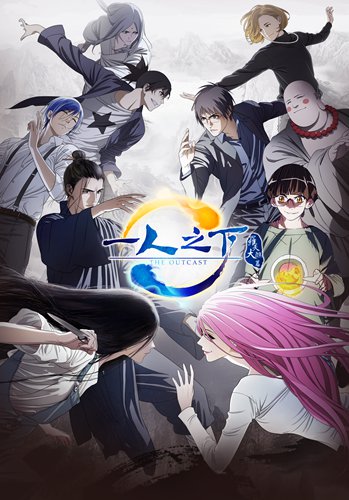Artists rethink how to package Chinese elements for foreign markets
By Li Lei Source:Global Times Published: 2019/6/12 18:33:39

A publicity poster of The Outcast Photo: Courtesy of Wang Xin
The 14th China Beijing International Cultural & Creative Industry Expo (ICCIE) on May 29 released an evaluation report on 74 pieces of cultural intellectual property (IP) from China that have "gone overseas" since 2018 in sectors such as film, TV series, games, literature, comics and animation.
Zhang Xuejing, a research fellow from the Liaowang Institute, a renowned Chinese think tank, said that high quality films with rich Chinese elements are the major forms in which Chinese cultural symbols "go out."
The report shows that overseas audiences are open to Chinese culture, but Chinese elements are not obvious in those Chinese cultural IPs that have "gone out."
According to the report, literature is the biggest source of Chinese cultural IPs that "go overseas," followed by mobile games. IPs from comics and animation scored last on the list because of poor development in the sector and lack of Chinese elements.
However, animation works The Outcast, and Fox Spirit Matchmaker, both of which were directed by Wang, were widely praised and popular with overseas audiences because of their unique Chinese elements.
The Outcast is set in the contemporary world, and tells the story of a group of Chinese born with superpowers drawn from Taoism.
Based on the Buddhist concept of metempsychosis, Fox Spirit Matchmaker is a funny and mysterious fairy story about a fox spirit playing matchmaker for her lover in the previous life.
Successfully 'going out'
Full of Taoist terms and internet catchphrases, the first season of The Outcast scored 8.8 on Douban, China's film rating website.
Screened in July 2016 in China, the animation soon entered Japan and attracted an army of fans in the country.
"In fact, young Japanese are very interested in Chinese culture," Wang told the Global Times, adding that in Japan the best-selling comics include One Piece, followed by Kingdom, which tells the Chinese historical story about how the first emperor of the Qin Dynasty (221BC-206BC) unified the six states.
Wang said most foreigners have an incomplete understanding of Chinese culture, as they believe it is all about Kungfu, cheongsams and dragon dances, aspects that Chinese films have frequently showcased in past decades.
Young foreign audiences have become tired of these rigid Chinese cultural icons.
According to danimestore, Japan's largest online animation website, The Outcast ranked sixth on the first day it was aired in Japan.
"Young people would be more open to Chinese culture if these icons were expressed in new forms such as music and animation," Wang said.
After being shown in Japan, The Outcast also attracted attention from other countries, as it has been translated by netizens into Spanish and English on YouTube.
Wang said that he read audience feedback on Twitter after every episode was aired in Japan, and there were hundreds of comments from other countries such as Thailand and South Korea discussing the Taoist terms and elements in the animation.
Cultural treasure trove
"Chinese animation is facing a new opportunity, as the world is eager to know more about the real China with the rise of China's economy," said Cai Zhijun, general manager of the CCTV Animation Studio Co, noting that China's animation production techniques and creative concepts have seen great progress.
However, it is never an easy job to translate cultural terms into another language and still maintain the same deeper meaning. Internet catchphrases, dialect and religious and culture-related terms are a highlight of animation works within China, but become an obstacle to bringing animation works overseas.
"Many religious and cultural terms are still hard to understand for Japanese people even after being translated into their language," said Wang. Eventually, the translation team adopted Japanese terms that had a close meaning and similar connotations.
"Chinese culture is such a treasure trove that one single historical feature can find a place in the Japanese comic sector," said Wang,
It is more important to stoke audience's interest in Chinese culture and guide them to proactively search for more information on the subject, according to Wang.
"Since Taoism cannot be clearly explained by an animation, we try to spark people's interest in Chinese culture by giving them a general picture of Taoism," he said.
"Young Japanese people were very interested in the Taoist elements after watching the animation," he noted.
"They would dig for more information on the culture behind a single item such as a tea cup, a sword, a roof, even a door."
The path ahead for Chinese animations going overseas is long and unclear, but with more Chinese animation successfully "going out," new opportunities also await.